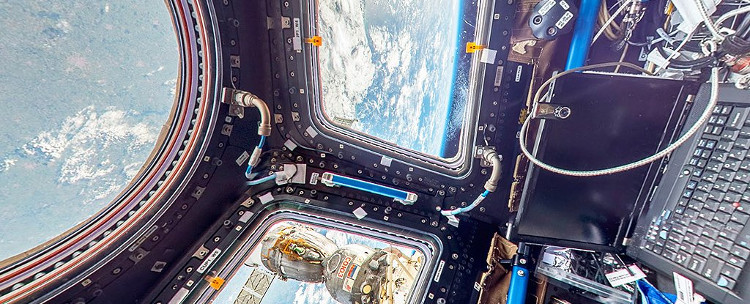Anyone can visit the International Space Station with Google Street View
You have used Google Street View to check your new apartment, traffic status before you leave. Now, the comprehensive ground map system has gone beyond the ground. Google Street View allows users to access the International Space Station from their computers at a height of 400km with 360-degree panoramic views.
The image of Street View was updated by Thomas Pesquet, an astronaut of the European Space Agency. He spent six months on the International Space Station to collect data and returned to Earth in June.
Google's Street View , which is featured in Google Maps and Google World, was launched in 2007. After the introduction, it quickly expanded locations worldwide, including locations. as far as Mount Everest or the legendary Loch Ness.
Most of the Street View view is captured by means of which their movement is always available for users to access online.
This is the first time that Google has "advanced" into space because the images of Street View have never been taken outside of Earth before.
In a blog post about his experience, Pesquet wrote: "It is difficult to find words or take a picture that accurately describes the feeling of being in space".
"Working with Google is one of my most recent jobs. With Google Street View, everyone can see the space of the International Space Station. And looking at the Earth from This space is really great, " he added.
This virtual trip allows users to learn about areas where astronauts eat, exercise, work and even bathe. Pesquet's image shows an environment that looks a bit cramped and chaotic - if not completely ambiguous - for those on Earth. But there are some scenes inside the International Space Station that are very charming.

Visit the International Space Station with Google.(Photo: Google Map).
The images were taken using DSLR cameras and then "stitched together" on Earth to create panoramic views. Pesquet noted that the International Space Station is a "busy place" with six astronauts working and studying 12 hours a day.
"There are many obstacles there, and we don't have much time to take pictures, so we have to be confident that our approach is effective , " he wrote.
On the International Space Station's online network, you'll notice blinking dots with detailed descriptions of space and that's where viewers can see exactly what they're watching. Pesquet notes that this is the first time - "useful little notes appear when you explore the International Space Station" - added to the Google Street View image.
The International Space Station is a "large spacecraft" that orbits the Earth at more than 1,600km / h and is home to astronauts from countries around the world. The multi-piece international space station was built by astronauts in 1998.
According to NASA, in 2000, many other pieces of other stations were built and it was ready to catch astronauts. NASA said the parts of the station are connected through modules called "nodes".
"The first astronauts arrived here on November 2, 2000. People have lived on the space station ever since. Over time, many parts have been added. NASA and its partners around the world have completed it. into space station in 2011 , "NASA said.
NASA compares inside the station with inside a house, they remind people to save on its special structure. It is very heavy and covers an area roughly equal to a football field; It has five bedrooms, two bathrooms, a gym and a large window.
The station has laboratories from the United States, Russia, Japan and Europe."We can collect data about ocean, atmosphere and soil surface , " Pesquet wrote.
"We can conduct experiments and studies that we cannot do from Earth, like tracking how the human body responds to small weights, solving the mysteries of the immune system, study the tornadoes to warn people and governments when the storm is coming in. Or track marine trash - the amount of waste is growing rapidly in our oceans , 'he added.
Several times a week, Mission Control at NASA's Johnson Space Center in Houston, Texas, determines where explorers can discover stations from the ground from thousands of locations worldwide.
- Visit 'the longest road' on the ISS International Space Station
- NASA opened the International Space Station for ... tourists and film makers from 2020
- Visit the scenery inside the ISS international space station
- Breathtaking view of space from the International Space Station
- Visit ISS international space station with 3D video
- How big is the International Space Station (ISS)?
- How does Google Maps work?
- International space station increased altitude by 2km
- Google calculates campus construction
- Russian space station will replace the US ISS global surveillance
- The uncertain future of the ISS space station when NASA returns to the Moon
- Looking back at the ISS space station after 15 years of operation
 Van Allen's belt and evidence that the Apollo 11 mission to the Moon was myth
Van Allen's belt and evidence that the Apollo 11 mission to the Moon was myth The levels of civilization in the universe (Kardashev scale)
The levels of civilization in the universe (Kardashev scale) Today Mars, the sun and the Earth are aligned
Today Mars, the sun and the Earth are aligned The Amazon owner announced a secret plan to build a space base for thousands of people
The Amazon owner announced a secret plan to build a space base for thousands of people